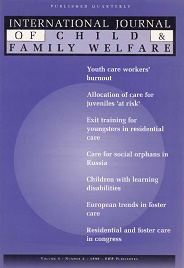Youth care workers' burnout. A comparison with youth workers working with normative youth and the implications of coping with it. An Israeli point of view
Abstract
This study investigates whether there are differences in the level of burnout in youth care workers working with detached youth in comparison with the level of burnout in youth workers working with normative youth. The study also investigates whether the years of experience in working affects the level of burnout in youth workers. A review of research on burnout and its influence on the worker is presented. The study hypotheses were: (1) the level of burnout in youth care workers is higher than the level of burnout in youth workers working with normative youth; (2) there is a significant relationship between years of experience in working and the level of burnout in workers with detached youth. The study findings confirmed the first hypothesis with respect to the greater burnout in youth care workers than in youth workers working with normative youth. No correlation was found between the years of experience in working and the level of burnout. The study findings indicate a need for a more-in-depth investigation into the causes of burnout characteristics with youth care workers of detached youth, and not necessarily related to years of experience. Such an investigation, which requires additional systematic research, will enable selecting the relevant and/or critical areas for developing an effective program for worker accompaniment and guidance. The program will help youth care workers engaged in complex, highly demanding and frustrating work, providing them with the multifaceted skills to deal with youth who have study-related problems and the arduous interaction with them, as well as the tools to deal with their own conflicting emotions that lead to burnout.

